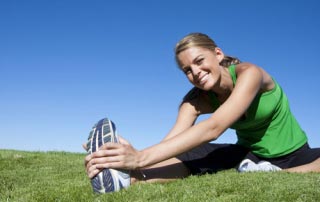
Tissues can become tight or stiff from an activity or with prolonged positioning, possibly leading to pain or difficulty performing simple tasks such as reaching overhead. Stretching is important to maintain flexibility of these tissues, increase joint range, and prevent loss of motion1,2. Various methods of stretching include static or isolated stretching, dynamic stretching, or the use of a foam roller for self-massage. Static stretching is holding a stretch position for a long period. Dynamic stretching uses movement to combine muscle groups and are often done repeatedly such as skipping, jumping, or walking toe touches.
Static stretching appears to be more beneficial for athletes requiring flexibility such as gymnasts or dancers while dynamic stretching may be better for athletes requiring running or jumping performance such as basketball players or sprinters3. Flexibility is most effective when the muscle is warm, therefore, it is recommended to warm-up with dynamic stretching prior to exercise and to follow up your program with static stretching. ACSM guidelines recommend that static stretching activities be done at least 2-3 days per week1,2. Each stretch should be held for 10-30 seconds in a position that produces a slight pull on the muscle but not to the point of pain, and be repeated 2-4 times1,2. The muscles that are most often tight are the hamstrings, hip flexors, calves and chest muscles1.
Hamstrings
Variation 1: Start lying on your back with one leg outstretched, flat in front. Grab the back of your leg, just below your knee and pull your leg in toward your chest. Gently straighten your leg, trying to keep your knee near your chest until you feel a gentle stretch. Hold the position, relax. Return to starting position and repeat.
Variation 2: Stand up tall and place one foot on the floor and maintain a straight leg. Lean your body slowly forward over your leg while keeping your knee straight, until you feel a stretch across the back of your thigh. Make sure you bend at your hips and not your waist, keep your back straight as you lean forward. Hold the position, relax. Return your body to the starting position and repeat.
Hip Flexors/Quads
Stand on one foot, and bring the other foot to the buttocks. Pull back gently, while keeping your knee pointed at the ground and your hip straight. If needed, hold onto a counter or chair to keep your balance.
Calves
Step forward with one leg. Shift your weight toward the front leg while keeping the back heel on the ground. If you press the hip of your back leg forward, this will also help stretch the hip flexors.
Chest muscles
Standing in a corner, bring hands up to shoulder height and place against the wall on either side. Keeping hands in position, lean body forward until a stretch is felt in the front of the chest. This can also be done using a doorway, with hands on either side of the door frame and leaning forward.
Seek out the assistance of a physical therapist for dynamic and static stretches to enhance your flexibility, joint range of motion, and activity performance.
- Millar AL. Improving Your Flexibility and Balance. ACSM Fit Society Page. 2012. Accessed June 29, 2015. https://www.acsm.org/access-public-information/articles/2012/02/02/improving-your-flexibility-and-balance
- Garber CE, Blissmer B, Deschenes MR, et al. Quantity and Quality of Exercise for Developing and Maintaining Cardiorespiratory, Musculoskeletal, and Neuromotor Fitness in Apparently Healthy Adults: Guidance for Prescribing Exercise. Med Sci Sports Exerc. 2011;43(7):1334-1359.
- Page, P. Current Concepts in Muscle Stretching for Exercise and Rehabilitation. Int J Sports Phys Ther. 2012 Feb; 7(1):109–119.